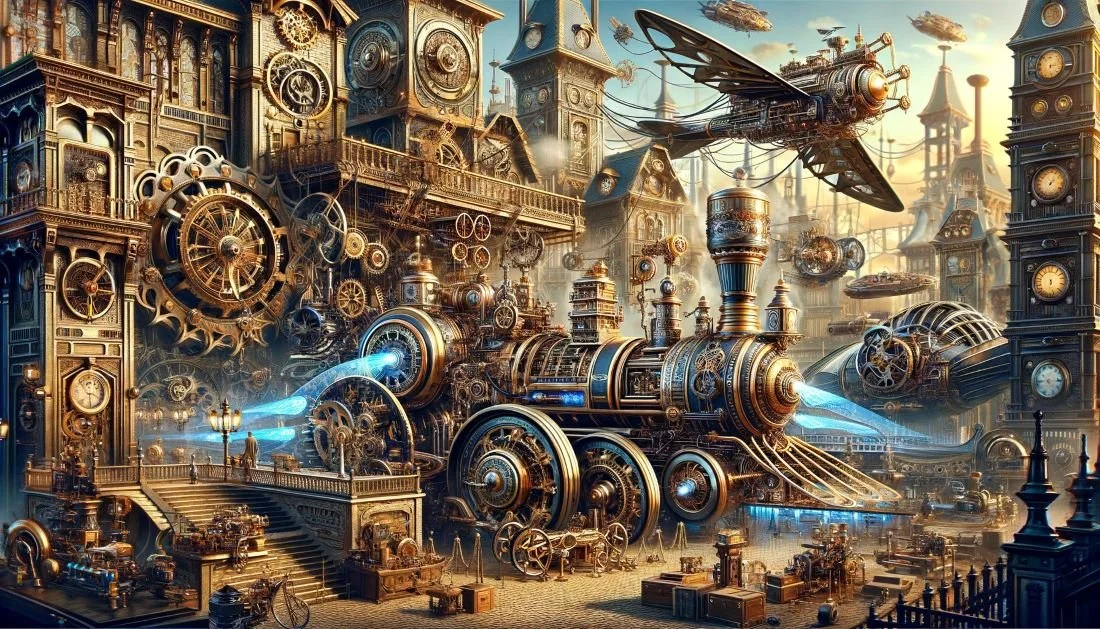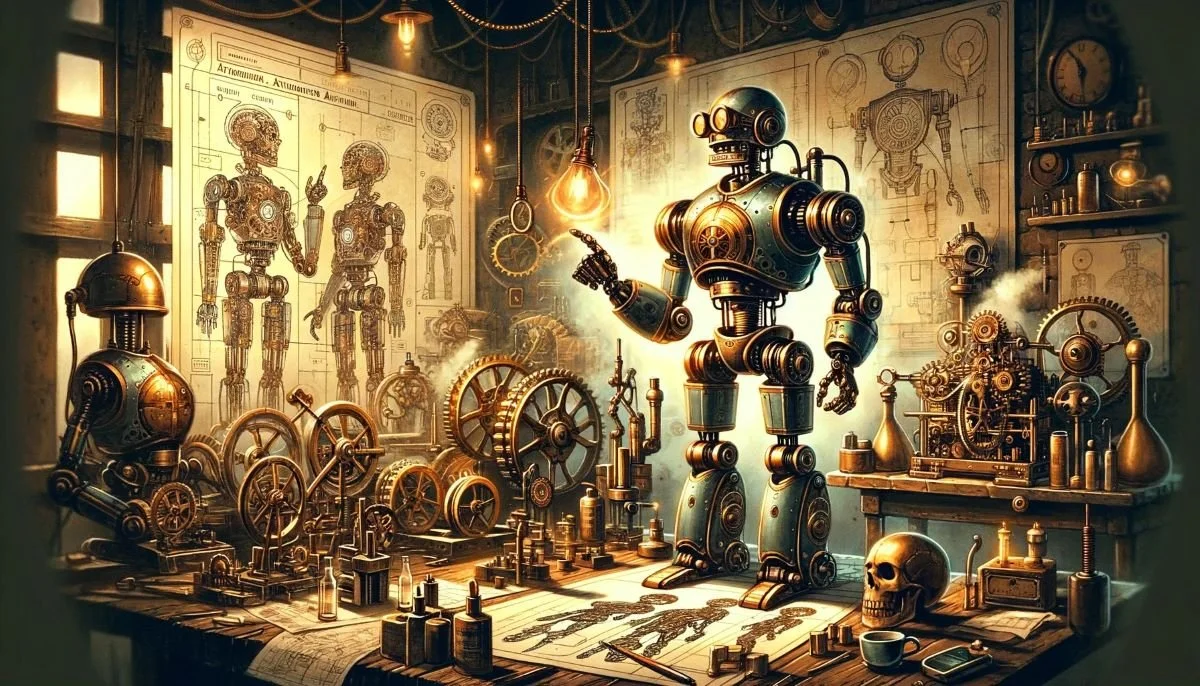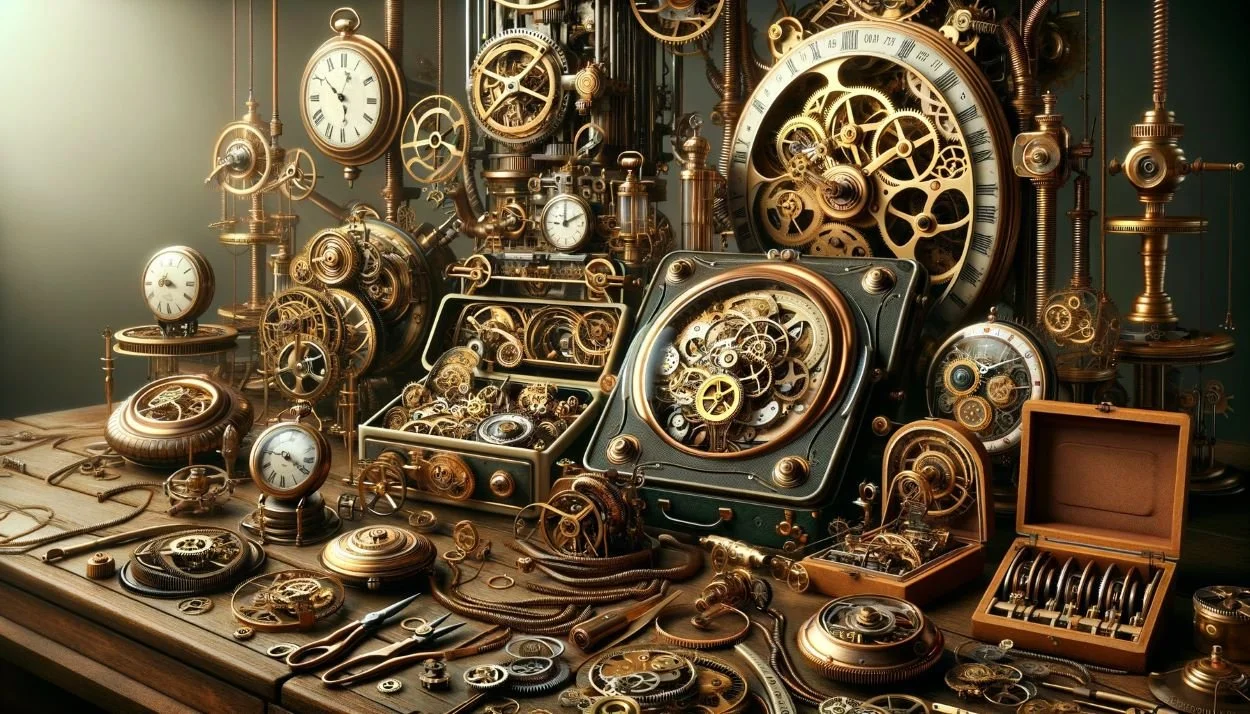Steampunk fantasy, a genre that blends Victorian-era aesthetics with futuristic technology, offers a unique playground for imagination and innovation. This blog post explores how technology not only shapes the narratives of steampunk fantasies but also reflects our own relationship with innovation and history.
Navigating Time: Technology’s Pivotal Role in Steampunk Fantasy
Bridging Eras: The Symphony of Victorian Craftsmanship and Futuristic Vision
Steampunk fantasy transcends mere genre to become a symphony of creativity, where the soot-covered machinery of the Victorian age intertwines with the limitless potential of tomorrow. This section explores the genre’s unique capacity to blend historical craftsmanship with prophetic innovation, making technology the narrative’s pulsating heart.
Victorian Craftsmanship: Celebrating the mechanical marvels of the 19th century, steampunk brings to life an era of steam-powered wonders and intricate contraptions. This nostalgic embrace highlights our yearning for the tangible and mechanical in a world drifting towards the intangible digital realm.
Futuristic Vision: While it honors the past, steampunk also propels us into an imaginative future. Here, airships soar through starry heavens, automatons undertake complex tasks, and brass and gears give birth to fantastical machines. This aspect encourages us to dream of a future where technology complements humanity, preserving our heritage.
Driving the Tale: Technology as Steampunk’s Storyteller
In steampunk, technology transcends its role as a mere backdrop to become a central character, guiding narratives and shaping destinies. This section examines how technology is intricately woven into the fabric of steampunk storytelling.
Plot Catalysts: Central to steampunk plots are pivotal technological elements – a groundbreaking airship, an enigmatic automaton, or a formidable steam engine. These are not just background elements but critical to driving the narrative forward, challenging characters with dilemmas and opportunities.
Symbolism and Reflection: Beyond functionality, steampunk technology often embodies deeper themes of progress, control, and the delicate dance between humanity and its creations. It prompts a contemplation of the moral and ethical dimensions of innovation, making steampunk a genre that entertains and provokes thought in equal measure.
A Mirror to Our World: Steampunk’s Reflection on Modern Technology
Steampunk is more than an escapist fantasy; it reflects our intricate relationship with technology. This section contemplates how steampunk’s portrayal offers profound insights into our contemporary existence.
Nostalgia Versus Caution: Steampunk’s fusion of the archaic and the avant-garde reveals a nostalgia for a time when technology felt more personal and understandable. Concurrently, it warns of a future where we might become subservient to our inventions. This resonance is particularly poignant in an era wrestling with the implications of AI and other emerging technologies.
Creative Responsibility: By revisiting the technologies of the past, steampunk inspires us to think inventively and responsibly about our resources. It urges us to innovate with conscience, considering the wider societal and ethical impacts of our creations.
In dissecting the role of technology in steampunk fantasy, we uncover a genre deeply connected to our past, present, and future. Steampunk doesn’t merely offer an imaginative retreat; it serves as a canvas for reflecting on our technological journey. Through its visionary tales, we are invited to ponder, to caution, and to aspire, affirming that technology is an integral part of our collective narrative.
Unveiling Steampunk: A Journey Through Time and Imagination
The Genesis of Steampunk: A Literary Legacy
Steampunk, a term first coined in the late 1980s, has roots that delve deep into the rich soil of 19th-century literature. It’s a genre that breathes life into the industrial steam-powered machinery of the Victorian era, blending it with a sprinkle of fantasy and speculative fiction. Let’s embark on a journey to understand the origins of this captivating genre.
Pioneering Authors: The seeds of steampunk were sown by visionary authors like H.G. Wells and Jules Verne. Their works, including classics such as “The Time Machine” and “20,000 Leagues Under the Sea,” laid the foundation for a genre that marries the scientific with the fantastical. These narratives, rich with inventive machinery and bold explorations, became the bedrock upon which steampunk would later be built.
Literary Evolution: Over the years, steampunk evolved from these literary roots into a distinct genre. Works like K.W. Jeter’s “Morlock Night” and James Blaylock’s “Homunculus” began to shape a world where Victorian aesthetics met futuristic innovation, creating a distinctive narrative style that’s as much about setting and atmosphere as it is about character and plot.
The Aesthetics of Steampunk: More Than Meets the Eye
Steampunk is an aesthetic feast, a genre that’s immediately recognizable for its distinctive style. It’s a visual and cultural phenomenon that extends beyond literature into fashion, art, and cinema.
Victorian Elegance Meets Futuristic Innovation: At the heart of steampunk aesthetics lies a juxtaposition. The elegance and propriety of Victorian fashion, with its corsets, top hats, and waistcoats, clash beautifully with the rugged, mechanical elements of futuristic innovation. Brass, leather, gears, and goggles become not just accessories but symbols of a world reimagined through the lens of the past.
Modern Media and Fashion: Steampunk’s influence extends well beyond the page. Films like “The League of Extraordinary Gentlemen” and “Steamboy” bring the genre’s visuals to life, while fashion designers draw inspiration from its unique blend of historical and fantastical elements. In the realm of art and design, steampunk has sparked a creative revolution, giving rise to everything from intricately crafted jewelry to spectacular themed events.
Steampunk Today: A Living, Breathing Culture
Steampunk is more than a genre or aesthetic; it’s a living, breathing subculture. With a vibrant community of enthusiasts, it continues to evolve and influence.
Global Community: From conventions and festivals to online forums and clubs, steampunk has fostered a global community of fans and creators. These gatherings are not just celebrations of a genre but immersive experiences where participants live out the fantasy, donning elaborate costumes and engaging in role-play.
Influence on Modern Creativity: The principles of steampunk creativity—combining the old with the new, the elegant with the rugged—have influenced a wide array of artistic and design fields. It encourages a unique perspective on creativity, one that sees potential beauty in the fusion of seemingly disparate elements.
In exploring the origins and aesthetics of steampunk, we uncover a genre that’s as complex as it is captivating. It’s a testament to the power of imagination, a cultural phenomenon that invites us to ponder what the future might have looked like through the eyes of the past. Steampunk is not just about looking backward; it’s about dreaming forward, about envisioning a world where the boundaries of time and technology blur into a realm of endless possibility.
The Machinery of Dreams: Delving into Steampunk’s Iconic Technologies
Airships: Soaring Symbols of Adventure and Discovery
Airships are perhaps the most emblematic technology of the steampunk genre, representing the human spirit’s unyielding desire to explore and conquer new frontiers. These majestic vessels, often depicted as massive, dirigible-like structures powered by steam and intricate clockwork mechanisms, capture the essence of steampunk’s blend of historical elements with a touch of the fantastical.
The Allure of the Skies: Airships in steampunk narratives are more than modes of transportation; they are symbols of adventure, freedom, and the endless possibilities that lie beyond the horizon. Their presence in stories often heralds epic journeys and daring exploits, echoing humanity’s timeless fascination with the skies.
Technological Marvels: Beyond their symbolic significance, steampunk airships are marvels of imaginary engineering. Featuring ornate designs that fuse Victorian elegance with futuristic innovation, these vessels embody the genre’s creative spirit, inspiring awe and wonder in readers and viewers alike.
Steam-Powered Automatons: Reflections of Ingenuity and Ambition
Automatons, or self-operating machines, are central to steampunk’s technological landscape. These steam-powered beings, ranging from humanoid robots to complex mechanical contraptions, showcase the genre’s inventive take on technology and its potential to mirror human aspirations and fears.
The Human Touch: Steampunk automatons are often portrayed with a level of craftsmanship and detail that imbues them with a sense of personality and purpose. They reflect the human desire to create and control, to imbue our tools with life and agency. As characters in their own right, they raise intriguing questions about the nature of consciousness and the relationship between creator and creation.
A Double-Edged Sword: While automatons represent the heights of innovation and creativity, they also serve as cautionary tales about the dangers of unchecked technological progress. Their stories can explore themes of autonomy, morality, and the consequences of playing god, adding depth and complexity to the steampunk narrative.
Clockwork Devices: The Intricate Heart of Steampunk Aesthetics
Clockwork mechanisms are quintessential to steampunk, serving as the literal and figurative gears that drive its technology. From pocket watches to sprawling machines, these intricate devices symbolize the genre’s fascination with precision, complexity, and the beauty of functional art.
Precision and Craftsmanship: Clockwork devices in steampunk are not just functional; they are crafted with an attention to detail that elevates them to art. They represent a harmony between form and function, showcasing the skill and dedication required to master the mechanical arts.
Symbolism of Time: Beyond their physical beauty, clockwork mechanisms carry rich symbolic weight. They remind us of the relentless march of time and our attempts to measure, control, and make sense of it. In steampunk narratives, they can represent everything from the inevitability of progress to the cycles of history and nature.
In exploring the iconic technologies of the steampunk genre, we uncover a world where dreams and reality intertwine, where the machinery of the imagination sets the stage for tales of adventure, discovery, and reflection. These technologies are not merely tools or decorations; they are integral to the storytelling, character development, and thematic exploration that make steampunk a genre that continues to captivate and inspire. Through its visionary tech, steampunk invites us to dream bigger, to look beyond the limitations of the present, and to imagine what might be possible in a world where creativity knows no bounds.
Steampunk’s Reflection of Modern Technology: A Mirror to Today’s Digital Age
The Paradox of Progress: Steampunk’s Critique of Modern Advancements
Steampunk is not merely a nostalgic escape to a bygone era; it’s a lens that sharply focuses on the rapid pace of today’s technological advancements. This section delves into how the genre critiques modern society’s relentless pursuit of progress, offering a thought-provoking perspective on the benefits and drawbacks of our tech-driven world.
The Allure and Anxiety of Innovation: Steampunk narratives often juxtapose the wonder of invention with the anxieties of unchecked progress. They reflect our own ambivalence towards technology—our celebration of its capabilities and our concerns about its implications. Through its retro-futuristic lens, steampunk allows us to scrutinize the trajectory of our technological evolution and its impact on human values and relationships.
Societal Impacts and Moral Dilemmas: By reimagining the past, steampunk highlights the societal impacts of technology. It explores themes like the widening gap between the haves and have-nots, the potential loss of individuality in an automated world, and the ethical dilemmas posed by scientific advancement. These narratives prompt us to consider if our pursuit of progress is leading us to utopia or dystopia.
The Nostalgic Lens: Longing for a Simpler Time
In an age where technology often outpaces our ability to understand it, steampunk offers a nostalgic yearning for a time when machinery was tangible and comprehensible. This section explores how the genre’s romanticization of the past provides a contrast to our complex digital present.
Tangible Technology: Unlike today’s invisible digital systems, the technology in steampunk is visible, tactile, and understandable. Gears, levers, and steam evoke a sense of nostalgia for a time when the workings of technology were clear. This longing speaks to a deeper desire for transparency and control in an era where technology often feels opaque and overwhelming.
Simplicity vs. Complexity: Steampunk’s simpler, mechanical world serves as a counterpoint to our complex, interconnected digital age. It reminds us of a time when technology enhanced life without consuming it, prompting a reflection on how we can balance the benefits of modern technology with a longing for simplicity and human connection.
Bridging the Digital Divide: Steampunk’s Social Commentary
Steampunk doesn’t just critique the pace of technological change; it also sheds light on the resulting social issues, such as the digital divide. This section examines how the genre uses its unique setting to discuss the disparities and inequalities exacerbated by modern technology.
Access and Inequality: Just as steampunk worlds often feature stark contrasts between the tech-empowered elite and the struggling masses, our own world is marked by disparities in access to technology. Steampunk stories can serve as allegories for the digital divide, highlighting the need for equitable access to the benefits of innovation.
Privacy and Surveillance: With its intricate networks of gears and levers, steampunk also echoes our concerns about privacy in an increasingly surveilled world. It raises questions about who controls technology and for what purposes, prompting us to consider the balance between security and personal freedom in our own society.
Steampunk’s reflection of modern technology is a multifaceted critique that celebrates human ingenuity while cautioning against its excesses. By looking backward, the genre offers a unique perspective on our current technological landscape, encouraging us to ponder the path we’re on and where it might lead. Through its imaginative tales, steampunk doesn’t just entertain; it compels us to reflect on our relationship with technology, the societal impacts of our innovations, and the kind of future we want to build.
Crafting a Steampunk World: Essential Tips for Writers and Creators
Creating a steampunk world is an exhilarating challenge that blends history with imagination. This section is dedicated to providing writers and creators with practical advice to construct a rich, believable steampunk universe. Here’s how to balance historical accuracy with fantastical elements, develop a distinctive aesthetic, and seamlessly integrate technology into your narrative.
Balancing History and Fantasy: The Art of Selective Accuracy
To craft a convincing steampunk world, it’s crucial to strike a balance between historical authenticity and creative liberty.
Research is Key: Start with a solid foundation of research into the Victorian era. Understand the socio-economic conditions, fashion, architecture, and technological advancements of the time. This knowledge will lend credibility to your world and help you identify which aspects to maintain for authenticity.
Bend, Don’t Break: Once you have a grasp on history, decide where to bend reality. Introduce your fantastical elements in a way that feels organic to the world you’re building. Perhaps your alternate history features a prolonged industrial revolution, or an invention that changed the course of technology. The key is to make changes that feel plausible within the world’s context.
Developing a Distinctive Aesthetic: More Than Gears and Cogs
Steampunk is renowned for its distinctive look and feel. To make your world stand out, you’ll need to go beyond the clichés.
Visual Harmony: Think about how the elements of your world work together visually. Combine textures like brass, wood, and leather with Victorian fashion and architecture to create a cohesive aesthetic. Colors, materials, and even the style of your characters’ clothing can help solidify the look of your world.
Signature Style: Consider what makes your world unique. Perhaps it’s a particular technology that’s developed differently or a fusion with another culture’s aesthetics. Your world should have something that makes it instantly recognizable and distinctly yours.
Weaving Technology into the Fabric of Your Story
Technology isn’t just a backdrop in steampunk; it’s a character in its own right. Here’s how to integrate it meaningfully into your narrative.
Purposeful Technology: Each piece of technology should have a purpose in your world. It could be a plot device, a symbol of societal change, or an extension of a character’s identity. Think about the implications of each invention: how it changes everyday life, who has access to it, and how it affects the balance of power.
Organic Integration: Introduce technology in a way that feels natural to the setting and story. Show how people interact with it daily, whether they’re marveling at new inventions or taking complex machinery for granted. Your technology should feel like a natural part of the world, not something added just for the sake of aesthetics.
The Symphony of Elements
Crafting a steampunk world is like conducting a symphony, where history, fantasy, aesthetics, and technology must all work in harmony. By balancing these elements thoughtfully, you can create a steampunk universe that captivates and immerses your audience. Remember, the most compelling worlds are those that feel lived-in and real, even with their fantastical elements. So, dive into the details, unleash your creativity, and build a world that’s uniquely yours.
The Future of Steampunk: Navigating New Horizons with Technology
As we stand on the cusp of new technological eras, the future of steampunk as a genre and cultural movement is poised for exciting evolution. This section explores the potential transformations in steampunk aesthetics and themes, offering a glimpse into how this vibrant genre might adapt and innovate in the face of advancing technology.
Virtual Reality: Immersive Steampunk Worlds at Your Fingertips
One of the most thrilling prospects for the future of steampunk is its intersection with virtual reality (VR) technology. Imagine donning a headset and stepping into a fully-realized steampunk city, complete with clanking automatons and hissing steam engines.
Interactive Storytelling: VR could revolutionize the way we experience steampunk narratives, offering an immersive, interactive form of storytelling. Users could explore intricate worlds, solve puzzles using steampunk gadgets, or even shape the story’s outcome based on their choices.
A New Realm for Creators: For writers and artists, VR presents a new canvas for creativity. Designing steampunk environments in VR would allow creators to experiment with architecture, technology, and atmosphere in ways that are impossible in traditional media.
Eco-Conscious Steampunk: A New Shade of Green
As global awareness of environmental issues grows, steampunk might take on an eco-conscious edge. This new direction could blend the genre’s traditional focus on industrial aesthetics with a renewed emphasis on sustainability and harmony with nature.
Green Technology: Imagine steampunk worlds powered by alternative energy sources like solar steam engines or bio-fuels. These innovations could open up new narratives about resource scarcity, environmental responsibility, and the balance between progress and preservation.
Reimagined Aesthetics: Eco-conscious steampunk would also influence the genre’s visual style. Expect to see more natural materials like wood and stone, alongside the traditional brass and leather. This shift would represent a harmonious fusion of the organic and the mechanical, reflecting a more sustainable vision of the future.
The Globalization of Steampunk: Diverse Influences and Perspectives
Steampunk has the potential to become a truly global genre, incorporating influences from cultures around the world. As technology brings us closer together, steampunk could evolve to reflect a more diverse range of aesthetics, themes, and perspectives.
Cultural Fusion: Future steampunk narratives might blend Victorian aesthetics with elements from other historical periods and cultures. This fusion would enrich the genre, offering fresh stories and visual styles inspired by a wider range of traditions and histories.
Inclusive Storytelling: With a more global outlook, steampunk could also become a platform for stories that reflect a broader spectrum of experiences and viewpoints. This inclusivity would make the genre more relevant and resonant for a wide audience, ensuring its continued growth and vitality.
A Genre in Flux
As technology marches forward, so too does the potential for steampunk to evolve and adapt. From immersive virtual realities to eco-conscious reinterpretations, the future of this genre is as boundless as the imaginations of its creators and fans. Steampunk’s ability to blend the past with the future, the mechanical with the natural, and the familiar with the fantastical makes it uniquely positioned to thrive in a world of constant change. Whatever direction it takes, one thing is certain: the future of steampunk will continue to inspire, captivate, and challenge us in ways we can only begin to imagine.









0 Comments